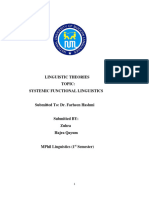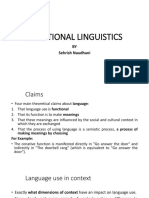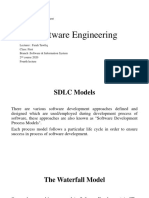0 ratings0% found this document useful (0 votes)
2 viewsFunctionalism
The document discusses functionalism in linguistics, emphasizing language as a dynamic tool for communication shaped by social and cognitive needs. It introduces Karl Bühler's Organon Model, which categorizes language functions into expressive, directive, and referential, while also addressing its strengths and criticisms. The conclusion highlights the model's significance in understanding language's role in human interaction and its influence on later linguistic theories.
Uploaded by
Mahum MunirCopyright
© © All Rights Reserved
Available Formats
Download as DOCX, PDF, TXT or read online on Scribd
0 ratings0% found this document useful (0 votes)
2 viewsFunctionalism
The document discusses functionalism in linguistics, emphasizing language as a dynamic tool for communication shaped by social and cognitive needs. It introduces Karl Bühler's Organon Model, which categorizes language functions into expressive, directive, and referential, while also addressing its strengths and criticisms. The conclusion highlights the model's significance in understanding language's role in human interaction and its influence on later linguistic theories.
Uploaded by
Mahum MunirCopyright
© © All Rights Reserved
Available Formats
Download as DOCX, PDF, TXT or read online on Scribd
You are on page 1/ 4
LINGUISTIC THEORIES
Major Assignment
Group Members
Mahum Munir (Karl Bühler)
Maham Abbasi (Roman Jakobson)
Sara Ameer, Sara (Michael Halliday)
M. Phil Linguistics
1st Semester – Fall 2024
Submitted To: Dr. Farheen Ahmed
Date: 23rd December 2024
Functionalism
Introduction:
Functionalism in linguistics is an approach that focuses on language as a tool for effective
communication. It investigates how language is used in real-life contexts to fulfill
communication, social interaction, and cognitive representation. It focuses on the relationship
between linguistic structures and their functions in social interaction, prioritizing how language
is used to convey meaning over its abstract forms. This approach contrasts with structuralism,
which studies language as a self-contained system of rules. Functionalism instead views
language as a dynamic, adaptive tool shaped by the needs of its users.
Core Principles of Functionalism:
i. Language is dynamic
Language evolves and adapts to meet communicative needs. Functionalists study linguistic
change as a response to social or cognitive pressures.
ii. Form-Function Relationship
Linguistic forms (e.g., words, sentence structures) are determined by the functions they serve.
Example: The use of passive voice (“The vase was broken by John”) highlights the object (vase)
rather than the subject (John).
iii. Contextual Relevance
Language cannot be studied in isolation; it must be understood in its social, cultural, and
situational contexts. Example: “Can you help me with this project?” is a request, not a question
about ones ability, because of the context.
1. Karl Bühler's Organon Model
The Organon Model of language, introduced by Karl Bühler in his book "Theory of Language"
(1934), is a foundational concept in functional linguistics. It explains how language functions as
a tool for communication by emphasizing the interplay between the speaker, the listener, and the
referent. The model views language as an organon (Greek for "tool" or "instrument") and
organizes it into three primary functions: expressive, directive, and referential.
i. Structure of the Model:
The Organon Model is represented using three key elements:
Speaker: The person producing the message (expression).
Listener: The recipient of the message (appeal).
Referent: The external object, fact, or reality being described (representation).
ii. The Three Core Functions of Language:
Expressive Function: In this type of function, speaker as the main focus of the message uses
language to express emotions, feelings or attitudes. This function is mostly relevant in poetry,
diaries, or casual conversation where personal expression is central.
Examples:
1) “I’m so tired.” (expressing fatigue)
2) “I love this song!” (expressing appreciation)
Directive Function: Here, language is directed at the listener to influence their behavior,
thoughts, or emotions. The focus is on the listener as the target of the message. This function is
evident in commands, persuasive speeches, advertisements, or instructions.
Examples:
1) “Please close the door.” (request)
2) “Watch out!” (warning)
Referential Function: Its purpose is to use language as a tool to describe objects, facts, or
external realities. The referent, or the topic of the communication is the main focus of this
function. This is the most common function in academic, scientific, and informative
communication.
Examples:
1) “The sky is blue.” (stating a fact)
2) “The meeting is at 3 PM.” (providing information)
iii. Strengths of the Organon Model:
It provides a comprehensive framework for analyzing language use in communication.
It is applicable to various contexts, including literature, education, and everyday speech.
The model influenced later functional linguistics, including Roman Jakobson’s six
functions of language and Michael Halliday’s systemic functional linguistics.
iv. Criticisms of the Organon Model:
Critics argue that it oversimplifies the complexity of language by limiting it to three
functions.
The boundaries between the functions can be blurry, as language often performs multiple
functions simultaneously.
The model emphasizes the speaker’s role more than the listener’s interpretation or
interaction.
Conclusion: By highlighting the expressive, directive, and referential functions, it provides a
holistic view of language as a tool for human interaction. Despite its limitations, the model’s
focus on the symbolic and contextual nature of language has laid the groundwork for subsequent
theories in discourse analysis, pragmatics, and communication studies.
You might also like
- Discovery of Cells and The Development of Cell Theory100% (1)Discovery of Cells and The Development of Cell Theory2 pages
- Tema 3: The Communicative Process The Functions of Language Language in Use Meaning NegotiationNo ratings yetTema 3: The Communicative Process The Functions of Language Language in Use Meaning Negotiation5 pages
- THe Idiolect, Chaos and Language Custom Far from Equilibrium: Conversations in MoroccoFrom EverandTHe Idiolect, Chaos and Language Custom Far from Equilibrium: Conversations in MoroccoNo ratings yet
- Submitted To Pro - Dr. Abbas Luffi by M.A - Student Ayser Basheer Ch.3 Why Formal Links Are Not Enough (Guy Cook)No ratings yetSubmitted To Pro - Dr. Abbas Luffi by M.A - Student Ayser Basheer Ch.3 Why Formal Links Are Not Enough (Guy Cook)11 pages
- Introduction To Jakobsons Functions of LanguageNo ratings yetIntroduction To Jakobsons Functions of Language8 pages
- Session 1 Functionalism Origin and DefinitionNo ratings yetSession 1 Functionalism Origin and Definition14 pages
- What Are Language Functions_ - The Language LibraryNo ratings yetWhat Are Language Functions_ - The Language Library2 pages
- 2.format. Hum-Basic Concepts in SociolinguisticsNo ratings yet2.format. Hum-Basic Concepts in Sociolinguistics7 pages
- Discourse Analysis: Why Formal Links Are Not Enough?No ratings yetDiscourse Analysis: Why Formal Links Are Not Enough?7 pages
- Unidade 3 - o Proceso de Comunicación-Funcións Da Linguaxe-Negociación Do SignificadoNo ratings yetUnidade 3 - o Proceso de Comunicación-Funcións Da Linguaxe-Negociación Do Significado10 pages
- Roman Jakobson - The Functions of Language - Signo - Applied Semiotics TheoriesNo ratings yetRoman Jakobson - The Functions of Language - Signo - Applied Semiotics Theories7 pages
- Temario Completo - Temas Desarrollados - Inglés PrimariaNo ratings yetTemario Completo - Temas Desarrollados - Inglés Primaria763 pages
- Chapter 1 - The Foundation of LinguisticsNo ratings yetChapter 1 - The Foundation of Linguistics7 pages
- Chomsky Pointed Out:: Textual, Interpersonal, and IdeationalNo ratings yetChomsky Pointed Out:: Textual, Interpersonal, and Ideational13 pages
- Wepik Adopt A Pub Pitch Deck 202410091811188PPANo ratings yetWepik Adopt A Pub Pitch Deck 202410091811188PPA11 pages
- Linguistic modality in Shakespeare Troilus and Cressida: A casa studyFrom EverandLinguistic modality in Shakespeare Troilus and Cressida: A casa studyNo ratings yet
- Lecture Session 1 Language and PhiolosophyNo ratings yetLecture Session 1 Language and Phiolosophy11 pages
- GE BDD 15 & BDD 16 Testing Notes Not Inclusive.: General ConnectionsNo ratings yetGE BDD 15 & BDD 16 Testing Notes Not Inclusive.: General Connections2 pages
- ISO 15189 Accreditation: Benita I.Haines Corporate Compliance and Quality Manager For Valley Health July 19, 2009No ratings yetISO 15189 Accreditation: Benita I.Haines Corporate Compliance and Quality Manager For Valley Health July 19, 200915 pages
- Specialized Cte Industry Certification ListNo ratings yetSpecialized Cte Industry Certification List14 pages
- Grade 7 - Geography - Term 2 - AK Mock TestNo ratings yetGrade 7 - Geography - Term 2 - AK Mock Test5 pages
- DLL SHS STEM Grade 12 - General Biology1 Quarter1 Week1 (Palawan Division)100% (4)DLL SHS STEM Grade 12 - General Biology1 Quarter1 Week1 (Palawan Division)13 pages
- Week 4 Quiz: Differential Calculus: Uses of The Derivative: Increasing and Decreasing FunctionsNo ratings yetWeek 4 Quiz: Differential Calculus: Uses of The Derivative: Increasing and Decreasing Functions7 pages
- Barnardos Domestic Violence Risk Identification Matrix-2No ratings yetBarnardos Domestic Violence Risk Identification Matrix-21 page
- Petroleum Engineering Course ArrangementNo ratings yetPetroleum Engineering Course Arrangement1 page
- Affinity Laws For Variable Speed Centrifugal PumpsNo ratings yetAffinity Laws For Variable Speed Centrifugal Pumps4 pages
- Dual Full-Bridge MOSFET Driver With Microstepping TranslatorNo ratings yetDual Full-Bridge MOSFET Driver With Microstepping Translator18 pages
- Labtest Betp1323 - Rolling - Answer SchemeNo ratings yetLabtest Betp1323 - Rolling - Answer Scheme2 pages
- BMU Titan Cradle: Standard Features Control BoxNo ratings yetBMU Titan Cradle: Standard Features Control Box2 pages
- Software Engineering: University of Technology Computer Science DepartmentNo ratings yetSoftware Engineering: University of Technology Computer Science Department13 pages
- Discovery of Cells and The Development of Cell TheoryDiscovery of Cells and The Development of Cell Theory
- Tema 3: The Communicative Process The Functions of Language Language in Use Meaning NegotiationTema 3: The Communicative Process The Functions of Language Language in Use Meaning Negotiation
- THe Idiolect, Chaos and Language Custom Far from Equilibrium: Conversations in MoroccoFrom EverandTHe Idiolect, Chaos and Language Custom Far from Equilibrium: Conversations in Morocco
- Submitted To Pro - Dr. Abbas Luffi by M.A - Student Ayser Basheer Ch.3 Why Formal Links Are Not Enough (Guy Cook)Submitted To Pro - Dr. Abbas Luffi by M.A - Student Ayser Basheer Ch.3 Why Formal Links Are Not Enough (Guy Cook)
- Grammar Rules Explained: Clear and Concise GuidanceFrom EverandGrammar Rules Explained: Clear and Concise Guidance
- What Are Language Functions_ - The Language LibraryWhat Are Language Functions_ - The Language Library
- Discourse Analysis: Why Formal Links Are Not Enough?Discourse Analysis: Why Formal Links Are Not Enough?
- Language, Linguistics, and Development SimplifiedFrom EverandLanguage, Linguistics, and Development Simplified
- Unidade 3 - o Proceso de Comunicación-Funcións Da Linguaxe-Negociación Do SignificadoUnidade 3 - o Proceso de Comunicación-Funcións Da Linguaxe-Negociación Do Significado
- Roman Jakobson - The Functions of Language - Signo - Applied Semiotics TheoriesRoman Jakobson - The Functions of Language - Signo - Applied Semiotics Theories
- Temario Completo - Temas Desarrollados - Inglés PrimariaTemario Completo - Temas Desarrollados - Inglés Primaria
- Chomsky Pointed Out:: Textual, Interpersonal, and IdeationalChomsky Pointed Out:: Textual, Interpersonal, and Ideational
- Linguistic modality in Shakespeare Troilus and Cressida: A casa studyFrom EverandLinguistic modality in Shakespeare Troilus and Cressida: A casa study
- Language: an Introduction to the Study of SpeechFrom EverandLanguage: an Introduction to the Study of Speech
- GE BDD 15 & BDD 16 Testing Notes Not Inclusive.: General ConnectionsGE BDD 15 & BDD 16 Testing Notes Not Inclusive.: General Connections
- ISO 15189 Accreditation: Benita I.Haines Corporate Compliance and Quality Manager For Valley Health July 19, 2009ISO 15189 Accreditation: Benita I.Haines Corporate Compliance and Quality Manager For Valley Health July 19, 2009
- DLL SHS STEM Grade 12 - General Biology1 Quarter1 Week1 (Palawan Division)DLL SHS STEM Grade 12 - General Biology1 Quarter1 Week1 (Palawan Division)
- Week 4 Quiz: Differential Calculus: Uses of The Derivative: Increasing and Decreasing FunctionsWeek 4 Quiz: Differential Calculus: Uses of The Derivative: Increasing and Decreasing Functions
- Barnardos Domestic Violence Risk Identification Matrix-2Barnardos Domestic Violence Risk Identification Matrix-2
- Affinity Laws For Variable Speed Centrifugal PumpsAffinity Laws For Variable Speed Centrifugal Pumps
- Dual Full-Bridge MOSFET Driver With Microstepping TranslatorDual Full-Bridge MOSFET Driver With Microstepping Translator
- Software Engineering: University of Technology Computer Science DepartmentSoftware Engineering: University of Technology Computer Science Department

























































































